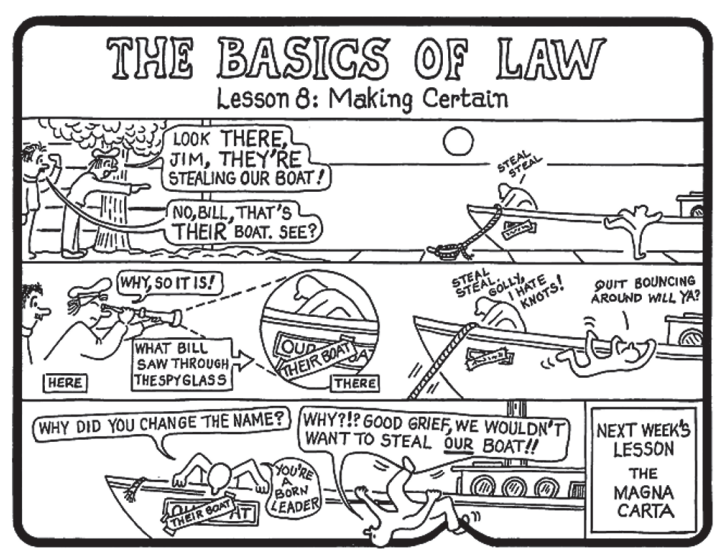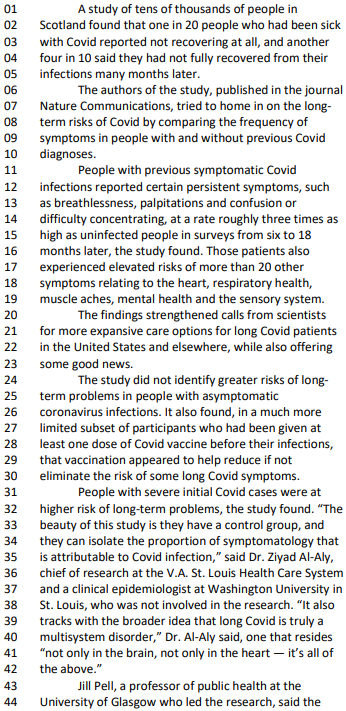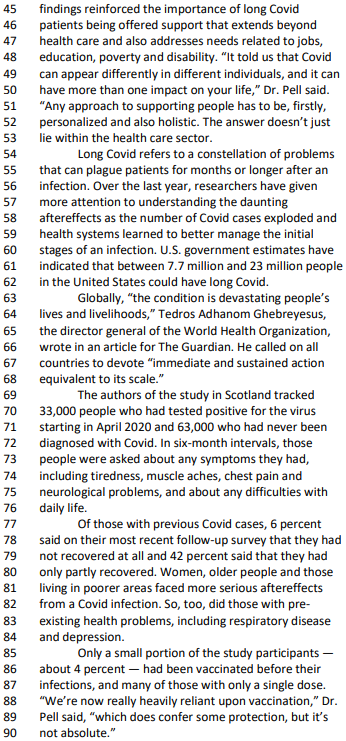Questões de Vestibular
Sobre interpretação de texto | reading comprehension em inglês
Foram encontradas 4.844 questões
This text refers to question
How to Stop Eating Sugar
By David Leonhardt
If you’re like most Americans, you eat more sugar than is good for you. But it’s entirely possible to eat less sugar without sacrificing much — if any — of the pleasures of eating. Surprising as it may sound, many people who have cut back on sugar say they find their new eating habits more pleasurable than their old ones. This guide will walk you through why sugar matters, how you can make smart food choices to reduce sugar consumption, and how you can keep your life sweet, even without so many sweets.
Here's why you eat more sugar than you realize, and why it's a problem. The first thing to know: Added sugars, of one kind or another, are almost everywhere in the modern diet. They’re in sandwich bread, chicken stock, pickles, salad dressing, crackers, yogurt and cereal, as well as in the obvious foods and drinks, like soda and desserts.
The biggest problem with added sweeteners is that they make it easy to overeat. They’re tasty and highly caloric but they often don’t make you feel full. Instead, they can trick you into wanting even more food. Because we’re surrounded by added sweeteners — in our kitchens, in restaurants, at schools and offices — most of us will eat too much of them unless we consciously set out to do otherwise.
It’s not an accident. The sugar industry has conducted an aggressive, decades-long campaign to blame the obesity epidemic on fats, not sugars. Fats, after all, seem as if they should cause obesity. Thanks partly to that campaign, sugar consumption soared in the United States even as people were trying to lose weight. But research increasingly indicates that an overabundance of simple carbohydrates, and sugar in particular, is the No. 1 problem in modern diets. Sugar is the driving force behind the diabetes and obesity epidemics. Fortunately, more people are realizing the harms of sugar and cutting back.
[...]
Changing your diet is hard. If your strategy involves thinking about sugar all the time — whenever you’re shopping or eating — you’ll likely fail. You’ll also be miserable in the process. It’s much more effective to come up with a few simple rules and habits that then become second nature. (One strategy to consider: Eliminate all added sugars for one month, and then add back only the ones you miss. It’s easier than it sounds.)
Above all, most people’s goal should be to find a few simple, lasting ways to cut back on sugar. Once you’re done reading this guide, we suggest you choose two or three of our ideas and try them for a few weeks.
https://www.nytimes.com/guides/smarterliving/how-to-stop-eating-sugar (text adapted)
This text refers to question
How to Stop Eating Sugar
By David Leonhardt
If you’re like most Americans, you eat more sugar than is good for you. But it’s entirely possible to eat less sugar without sacrificing much — if any — of the pleasures of eating. Surprising as it may sound, many people who have cut back on sugar say they find their new eating habits more pleasurable than their old ones. This guide will walk you through why sugar matters, how you can make smart food choices to reduce sugar consumption, and how you can keep your life sweet, even without so many sweets.
Here's why you eat more sugar than you realize, and why it's a problem. The first thing to know: Added sugars, of one kind or another, are almost everywhere in the modern diet. They’re in sandwich bread, chicken stock, pickles, salad dressing, crackers, yogurt and cereal, as well as in the obvious foods and drinks, like soda and desserts.
The biggest problem with added sweeteners is that they make it easy to overeat. They’re tasty and highly caloric but they often don’t make you feel full. Instead, they can trick you into wanting even more food. Because we’re surrounded by added sweeteners — in our kitchens, in restaurants, at schools and offices — most of us will eat too much of them unless we consciously set out to do otherwise.
It’s not an accident. The sugar industry has conducted an aggressive, decades-long campaign to blame the obesity epidemic on fats, not sugars. Fats, after all, seem as if they should cause obesity. Thanks partly to that campaign, sugar consumption soared in the United States even as people were trying to lose weight. But research increasingly indicates that an overabundance of simple carbohydrates, and sugar in particular, is the No. 1 problem in modern diets. Sugar is the driving force behind the diabetes and obesity epidemics. Fortunately, more people are realizing the harms of sugar and cutting back.
[...]
Changing your diet is hard. If your strategy involves thinking about sugar all the time — whenever you’re shopping or eating — you’ll likely fail. You’ll also be miserable in the process. It’s much more effective to come up with a few simple rules and habits that then become second nature. (One strategy to consider: Eliminate all added sugars for one month, and then add back only the ones you miss. It’s easier than it sounds.)
Above all, most people’s goal should be to find a few simple, lasting ways to cut back on sugar. Once you’re done reading this guide, we suggest you choose two or three of our ideas and try them for a few weeks.
https://www.nytimes.com/guides/smarterliving/how-to-stop-eating-sugar (text adapted)
This text refers to question
How to Stop Eating Sugar
By David Leonhardt
If you’re like most Americans, you eat more sugar than is good for you. But it’s entirely possible to eat less sugar without sacrificing much — if any — of the pleasures of eating. Surprising as it may sound, many people who have cut back on sugar say they find their new eating habits more pleasurable than their old ones. This guide will walk you through why sugar matters, how you can make smart food choices to reduce sugar consumption, and how you can keep your life sweet, even without so many sweets.
Here's why you eat more sugar than you realize, and why it's a problem. The first thing to know: Added sugars, of one kind or another, are almost everywhere in the modern diet. They’re in sandwich bread, chicken stock, pickles, salad dressing, crackers, yogurt and cereal, as well as in the obvious foods and drinks, like soda and desserts.
The biggest problem with added sweeteners is that they make it easy to overeat. They’re tasty and highly caloric but they often don’t make you feel full. Instead, they can trick you into wanting even more food. Because we’re surrounded by added sweeteners — in our kitchens, in restaurants, at schools and offices — most of us will eat too much of them unless we consciously set out to do otherwise.
It’s not an accident. The sugar industry has conducted an aggressive, decades-long campaign to blame the obesity epidemic on fats, not sugars. Fats, after all, seem as if they should cause obesity. Thanks partly to that campaign, sugar consumption soared in the United States even as people were trying to lose weight. But research increasingly indicates that an overabundance of simple carbohydrates, and sugar in particular, is the No. 1 problem in modern diets. Sugar is the driving force behind the diabetes and obesity epidemics. Fortunately, more people are realizing the harms of sugar and cutting back.
[...]
Changing your diet is hard. If your strategy involves thinking about sugar all the time — whenever you’re shopping or eating — you’ll likely fail. You’ll also be miserable in the process. It’s much more effective to come up with a few simple rules and habits that then become second nature. (One strategy to consider: Eliminate all added sugars for one month, and then add back only the ones you miss. It’s easier than it sounds.)
Above all, most people’s goal should be to find a few simple, lasting ways to cut back on sugar. Once you’re done reading this guide, we suggest you choose two or three of our ideas and try them for a few weeks.
https://www.nytimes.com/guides/smarterliving/how-to-stop-eating-sugar (text adapted)
This text refers to question
Science confirms: Dark chocolate and red wine helps keep you looking young
NEWSNER
Chocolate and wine, and not always together, are among life’s simple pleasures, but most of us think we should only indulge in these pleasures in moderation.
Granted chocolate and wine contain a high number of calories and I don’t need to explain what happens to our bodies and minds if we drink too much wine. But now scientists may have found a reason to indulge in these delicious things more often than we think.
A recent study found a powerful antioxidant present in dark chocolate and red wine; the effect of this antioxidant on our bodies could be a reason to celebrate. Scientists say the presence of resveratrol in these food items has a positive effect on the brain, heart, and lifespan. The most naturally abundant sources of resveratrol are plants, including the skin of red grapes, red wine, raw cocoa, and dark berries, like lingonberries and blueberries.
A team led by Professor Lorna Harries at the University of Exeter discovered that by treating worn-out human cells with a formulation of resveratrol the older cells started to divide. These older cells then developed longer telomeres – the protective tips on the ends of chromosomes which shorten as we age, according to Longevity Facts. It seemed a miracle that these old cells looked young again. The experiment was repeated several times and each time the result was rejuvenated cells.
According to scientists red wine, dark chocolate and some berries also help to reduce inflammation and strengthen the heart. This powerful antioxidant was also found to help ward off certain age-related diseases.
Certain metabolic diseases, including type 2 diabetes and heart disease, tend to occur as we age. In animal studies, severely restricting calories can help prevent some of these diseases.
Researchers found that resveratrol can mimic calorie restriction in some ways and found it to extend the lifespans of yeast, worms, flies and fish. To help avoid the excessive consumption of red wine, this antioxidant can also be found in dark chocolate, grapes, raspberries, plums, blueberries, cranberries, grape tomatoes, and pomegranate. These findings are fascinating and are a step to prolonging people’s life without affecting overall health.
Please share with all your friends and family so they know dark chocolate can finally be consumed guilt free!
https://en.stories.newsner.com/health/science-confirms-dark-chocolate-and-red-wine-helps-keep-you-looking-young/ Accessed on May, 7th. Slightly modified
This text refers to question
Science confirms: Dark chocolate and red wine helps keep you looking young
NEWSNER
Chocolate and wine, and not always together, are among life’s simple pleasures, but most of us think we should only indulge in these pleasures in moderation.
Granted chocolate and wine contain a high number of calories and I don’t need to explain what happens to our bodies and minds if we drink too much wine. But now scientists may have found a reason to indulge in these delicious things more often than we think.
A recent study found a powerful antioxidant present in dark chocolate and red wine; the effect of this antioxidant on our bodies could be a reason to celebrate. Scientists say the presence of resveratrol in these food items has a positive effect on the brain, heart, and lifespan. The most naturally abundant sources of resveratrol are plants, including the skin of red grapes, red wine, raw cocoa, and dark berries, like lingonberries and blueberries.
A team led by Professor Lorna Harries at the University of Exeter discovered that by treating worn-out human cells with a formulation of resveratrol the older cells started to divide. These older cells then developed longer telomeres – the protective tips on the ends of chromosomes which shorten as we age, according to Longevity Facts. It seemed a miracle that these old cells looked young again. The experiment was repeated several times and each time the result was rejuvenated cells.
According to scientists red wine, dark chocolate and some berries also help to reduce inflammation and strengthen the heart. This powerful antioxidant was also found to help ward off certain age-related diseases.
Certain metabolic diseases, including type 2 diabetes and heart disease, tend to occur as we age. In animal studies, severely restricting calories can help prevent some of these diseases.
Researchers found that resveratrol can mimic calorie restriction in some ways and found it to extend the lifespans of yeast, worms, flies and fish. To help avoid the excessive consumption of red wine, this antioxidant can also be found in dark chocolate, grapes, raspberries, plums, blueberries, cranberries, grape tomatoes, and pomegranate. These findings are fascinating and are a step to prolonging people’s life without affecting overall health.
Please share with all your friends and family so they know dark chocolate can finally be consumed guilt free!
https://en.stories.newsner.com/health/science-confirms-dark-chocolate-and-red-wine-helps-keep-you-looking-young/ Accessed on May, 7th. Slightly modified
Low-Context Versus High-Context Cultures
If you have traveled much, perhaps you have noticed that people in various parts of the world differ in how direct and explicit their language is. You may have spent time in both low- and high-context cultures in your travels, with context here referring to the broad range of factors surrounding every act of communication.
In a low-context culture, people are expected to be direct and to say what they mean. Individuals in lowcontext cultures prefer precise, concrete language for sending and receiving messages, and are unlikely to rely on the context of a message to determine its meaning. The United States is an example of a low-context society, as are Canada, Israel, and most northern European countries.
In contrast, people in a high-context culture — such as Korea and the cultures of Native Americans and the Maori of New Zealand — are taught to speak in a much less direct way. In such cultures, maintaining harmony and avoiding offense are more important than expressing true feelings. Speech is more ambiguous and people convey much more of their meaning through subtle behaviors and contextual cues, such as their facial expressions and tone of voice.
The difference between low-context and high-context cultures is evident in the ways in which people handle criticism and disagreement. In a low-context culture, a supervisor might reprimand an irresponsible employee openly, to make an example of the individual. The supervisor would probably be direct and explicit about the employee’s shortcomings, the company’s expectations for improvement, and the consequences of the employee’s failing to meet those expectations.
In a high-context culture, however, the supervisor probably wouldn’t reprimand the employee publicly for fear that it would put the employee to shame and cause the worker to “lose face.” Criticism in high-context cultures is more likely to take place in private. The supervisor would also likely use more ambiguous language to convey what the employee was doing wrong, “talking around” the issue instead of confronting it directly. To reprimand an employee for repeated absences, for example, a supervisor might point out that responsibility to coworkers is important and that letting down the team would be cause for shame. The supervisor may never actually say that the employee needs to improve his or her attendance record. Instead, the employee would be expected to understand that message by listening to what the supervisor says and paying attention to the supervisor’s body language, tone of voice, and facial expressions.
When people from low- and high-context cultures communicate with one another, the potential for misunderstanding is great. To appreciate that point, imagine that you’ve asked two of your friends to meet you tomorrow evening for a coffee tasting at a popular bookstore cafe. Tina, an American, says, “No, I’ve got a lot of studying to do, but thanks anyway.” Lee, who grew up in South Korea, nods his head and says, “That sounds like fun.” Thus, you’re surprised later when Lee doesn’t show up.
How can you account for those different behaviors? The answer is that people raised in a high-context culture (such as that of South Korea) are often reluctant to say no—even when they mean no—for fear of causing offense. Another person raised in the South Korean culture might have understood from Lee’s facial expression or tone of voice that he didn’t intend to go to the coffee tasting. If you, like Tina, grew up in a low-context society, however, then you probably interpreted his answer and his nods to mean he was accepting your invitation.
Referência Bibliográfica FLOYD, KORY. Communication Matters. New York: McGraw-Hill Education. 2018.
The traits of a person who’s grown up in a low-context culture country is



MALLOTE, Stan. The Painless Path to Proper English Usage: the basics of law, New York: St. Martin’s Press. 1986.
The option which reflects CORRECTLY the humor approach of the text “The Basics of Law” is









